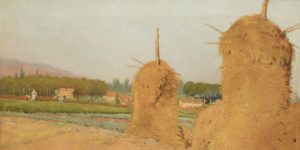1 result
Biografia
Pradilla's training is that of a painter of his time. Until 1865 he studied at the Academy of Zaragoza, later moving to Madrid, where he alternated copies at the Prado Museum with his studies at the San Fernando Royal Academy of Fine Arts. In 1874 he went as a pensioner to Rome, where he stayed for three years. In the paintings that he sent from the Italian capital, one could already see his ability to retain the climate of the time, environmental realism.
In Rome, in 1878, he produced what would be his great work, Doña Juana la Loca (Museo del Prado, Madrid), a historical figure for whom he felt a great attraction and to whom he dedicated various compositions. He soon found success in his country and abroad, and between 1879 and 1882 he painted The Surrender of Granada, his second great historical canvas, highly praised by critics and the public, one of the great history paintings of the 19th century in Spain.
In 1881 he was received as an academician from San Fernando and was appointed director of the Spanish Academy in Rome, a position from which he resigned after eight months to attend to his artistic commissions.
As the century languished, Pradilla's fortune took a turn for the worse. He lost all his savings as a result of the bankruptcy of the Villodas bank (1892), and his daughter died. Both events led him to a deep sadness and disinterest in art, although he had to overcome them, and he continued to increase his production. In 1896 he was appointed director of the Museo del Prado, a position from which he resigned two years later. He retired to his palace-studio in Madrid, where he lived in seclusion until the end of his days.
The year 2021 was the centenary of his death. In Pradilla's hometown, Villanueva de Gállego, Zaragoza, they celebrated the year, which they have called Año Pradilla, and made a retrospective on the life and work of the painter. The exhibition took place at the Museum of Zaragoza, in which thirty works by the painter were presented, allowing us to learn more about the different stages of the artist's life, from his training in Zaragoza and Madrid, his time in Rome, and his time as director of the Prado Museum.



